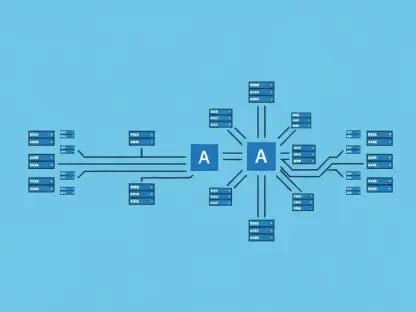In this insightful discussion with Vijay Raina, a seasoned expert in enterprise SaaS technology and software architectures, we explore the intricacies of data conflict resolution within enterprise systems. As systems scale, particularly in environments characterized by concurrent operations such as claims adjudication, locking mechanisms evolve beyond traditional database management to encompass a full-stack approach, affecting system consistency, user experience, and trust. Vijay shares his expertise on balancing optimistic and pessimistic locking strategies, improving observability, and ensuring data integrity within distributed architectures.
What are some common challenges enterprise systems face with data conflict resolution due to concurrent operations?
In enterprise systems, especially those with high levels of concurrent operations, ensuring data consistency is difficult. The simultaneous access to shared records by various users can result in conflicts, which can jeopardize data integrity. Traditional systems used row-level locks, but as enterprises scale, data is distributed across multiple services and locations, demanding more complex solutions. The major challenge is providing a seamless user experience where conflicts are resolved silently without burdening the users or breaking the system’s trust.
How did the claims adjudication system experience shifts in locking mechanisms as it scaled?
As the claims adjudication system scaled, we realized that locking mechanisms needed to transition from being solely database-oriented to a more integrated approach throughout the entire system. Initially, row-level locks were effective, but as we moved to a distributed architecture, it became essential to employ locking strategies that could manage consistency across different components and services. This shift was necessary to handle parallel workflows and ensure data integrity despite simultaneous record access by multiple users.
Can you explain the difference between locking in traditional RDBMS systems and locking in distributed systems?
In traditional RDBMS systems, locking is typically at the row level within a single database location. This allows direct management of conflicts arising from concurrent transactions. However, in distributed systems, data is dispersed across containers, services, and possibly geographic regions. Therefore, locking extends beyond simple database tactics to involve strategies that maintain consistency across these varied components. This involves sophisticated mechanisms that can handle distributed locks, such as utilizing in-memory data stores like Redis to manage concurrency control centrally.
What are the main philosophies for data conflict resolution, and how do they extend beyond database access methods?
Data conflict resolution revolves around two main philosophies: optimistic and pessimistic locking. Optimistic locking assumes minimal conflict—it’s useful where operations are less likely to interfere, employing techniques like version checks to reconcile data changes. Pessimistic locking, on the other hand, is crucial where conflicts are expected and dangerous, locking resources until tasks are explicitly completed. These philosophies go beyond database access; they influence how workflows are designed, how messages are queued, and even how teams collaborate within the system, providing a comprehensive approach to conflict management.
How does optimistic locking operate, and in what scenarios is it most effective?
Optimistic locking operates on the principle that most data transactions don’t conflict. It involves checking a version or timestamp when a transaction begins and ensuring it’s unchanged when ready to commit. This is highly effective in scenarios where users operate independently, such as asynchronous tasks or batch processes. For instance, in a large-scale insurance claim intake system, optimistic locking allows different users to process files concurrently without blocking each other, fostering enhance speed and scalability.
What were the successes and limitations of using optimistic locking in the insurance claim intake system?
The optimistic locking mechanism was quite successful in the insurance claim intake system as it allowed for efficient parallel processing, reducing wait times for claim processors and enhancing throughput. The system could operate smoothly even with multiple handlers working asynchronously on the documents. However, its limitation was evident in scenarios with high simultaneous edits, leading to version mismatches and user prompts for manual reconciliation. This highlighted the necessity of balancing such a strategy with user-friendly conflict resolution interfaces to manage exceptions effectively.
Describe pessimistic locking and why it was essential for the claims adjudication module?
Pessimistic locking is utilized when conflicts are frequent and potentially detrimental. It involves obtaining an exclusive lock on data resources, preventing concurrent edits until the lock holder completes their transaction. This mechanism was crucial for the claims adjudication module as it handles sensitive operations such as financial calculations where consistency and accuracy are non-negotiable. By employing strict controls, we ensured that critical processes remained error-free, maintaining data integrity and reliability in financial reimbursements.
How did you address the issue of lock abandonment in the pessimistic locking model?
Lock abandonment was a significant concern in the pessimistic locking model, as it could block others indefinitely. We tackled this by incorporating lock expiration mechanisms that set time-outs for automatic lock release. Additionally, we implemented a lock dashboard that allowed system administrators to monitor locks and intervene by reassigning or releasing them when necessary. This strategy minimized data availability issues while ensuring that locking remained a helpful tool rather than a bottleneck.
How can locking become a system-wide decision across different services within microservices architectures?
In microservices architectures, where services operate independently but on shared resources, locking must be seen as an overarching strategy rather than isolated incidents. It requires a unified approach that allows each service to respect lock states determined by others, which can be achieved by using shared registries like Redis. This way, locks become binding across services, encompassing different APIs and queues, preventing conflicting operations that could compromise data consistency or system stability.
What role did Redis play in managing locks across distributed architectures?
Redis served as a shared lock registry that centralized lock management within our distributed architecture. By maintaining locks elsewhere than individual service silos, Redis ensured that locks were respected system-wide, which was vital for maintaining data integrity across microservices. Its ephemeral nature also prevented stale locks, as any down service would automatically lose its locks, thereby preventing indefinite blocking—a common pitfall in distributed systems.
In what types of operations did you find advantageous to use optimistic strategies with in-app version tracking?
Optimistic strategies were particularly beneficial for operations with low risk of conflict, such as tagging files or updating non-critical metadata. These operations don’t typically interfere with core business processes, so they’re ideal candidates for a version tracking mechanism. This approach helps maintain a flexible, efficient workflow where users can proceed without being bottlenecked by the need for strict coordination, contributing to a smooth user experience and operational efficiency.
How did you make conflict visibility a first-class feature in large-scale locking systems?
To elevate conflict visibility, we streamed lock lifecycle events—such as acquisition, rejection, and release—into our log analytics pipeline. This translated locking activities into actionable data that could be visualized and analyzed, highlighting contested records and contention hotspots. Such transparency transformed conflict management into an active, measurable component of our system’s operation, encouraging proactive tuning and timely decision-making to improve overall performance.
What was the approach used to improve observability around locking systems and contention hotspots?
Improving observability involved integrating real-time logging and analytics, capturing lock-related events across the system for analysis. Dashboards displayed metrics like the frequency of lock contention, retries, and the duration of lock states. This allowed us to pinpoint contention hotspots quickly and provided insights into how our systems were operating. By leveraging this data, we could refine our strategies dynamically, such as tweaking lock durations and training users to minimize conflicts efficiently.
Explain how you made conflict resolution measurable and tunable through log analytics.
By streaming lock events into a centralized log analytics system, we turned what was previously a nebulous aspect of system operation into something tangible. This allowed us to measure the frequency of conflicts, the number of retries or failed attempts, and where resource contention was highest. As a result, teams had the data necessary to fine-tune conflict resolution strategies actively. We could adjust time-outs, refine retry logic, and enhance user education, making conflict resolution a configured, adaptive process rather than a fixed entity.
Why is it beneficial to combine both optimistic and pessimistic locking in enterprise systems?
Combining both locking strategies leverages the strengths of each, optimizing for various scenarios. Not all workflows in an enterprise system are suited to one method; some require the strict controls of pessimistic locking, while others benefit from the flexibility of optimistic approaches. This dual strategy allows for nuanced handling of data access, aligning technical constraints with business needs and ensuring that processes maintain integrity and performance without over-restricting operations.
How did lock-aware components contribute to flexible locking strategies based on user roles and business cases?
Lock-aware components enabled us to adapt locking strategies dynamically based on user roles and specific business processes. This meant that within the same system, actions could have different locking requirements—a field agent’s access might default to more restrictive, while support users could override certain locks. Such configurability allowed us to govern system interactions finely, offering tailored access restrictions that reflected real business logic and user needs, enhancing overall system usability and governance.
What impact did configurability of lock-aware components have on system governance?
The configurability of lock-aware components significantly enhanced system governance by aligning locking policies with organizational roles and business imperatives. Administrators could adjust settings based on current needs without changing code, ensuring that the system remains responsive to evolving business environments. This flexibility allowed locking to become a governance tool rather than a system constraint, providing the ability to implement consistent, policy-driven access controls across various user interactions and business processes.
In what ways should data conflict resolution be viewed in enterprise systems where collaboration and concurrency are prevalent?
In environments where collaboration and concurrency are the norms, conflict resolution should be seen as an integral part of the system’s design rather than an afterthought. It should focus on maximizing efficiency and user experience while safeguarding data integrity. This involves adopting an adaptive approach to locking, incorporating visibility and analytics to monitor and adjust strategies in real-time. By viewing it as a fluid, dynamic capability, enterprises can better manage concurrent operations, facilitating smoother workflows and fostering meaningful collaboration without sacrificing system trust or data consistency.









